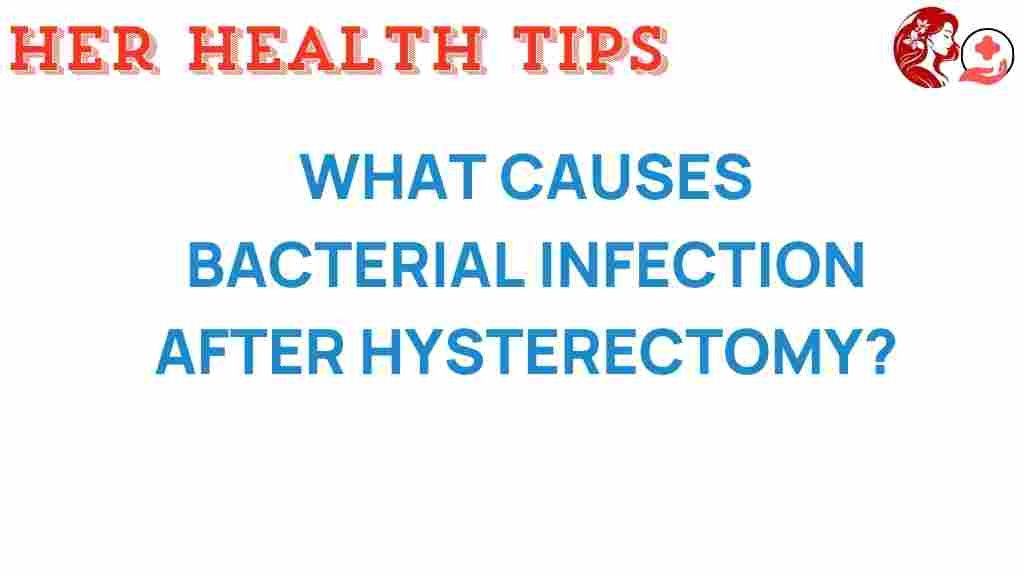Unveiling the Mystery: What Causes Bacterial Infection After Hysterectomy?
Hysterectomy is a significant surgical procedure that involves the removal of the uterus and is often performed to treat various gynecological conditions. While many women undergo this surgery successfully, it is important to be aware of potential post-surgery complications, including bacterial infections. Understanding what causes these infections can help patients and healthcare providers take proactive measures to ensure better outcomes in women’s health.
The Importance of Understanding Bacterial Infections
Bacterial infections can pose serious risks following any surgical procedure, particularly in gynecological surgery like hysterectomy. These infections can lead to extended recovery times, additional treatments, and in severe cases, complications that may threaten a woman’s overall health. Therefore, understanding how these infections occur is crucial for both patients and healthcare professionals.
What Is a Bacterial Infection?
A bacterial infection occurs when harmful bacteria invade the body, multiply, and cause illness. Symptoms can vary based on the infection’s location and severity, but common signs include:
- Fever and chills
- Redness, swelling, or warmth around the surgical site
- Pain or tenderness
- Discharge that may be foul-smelling
Causes of Bacterial Infection After Hysterectomy
Understanding the causes of bacterial infections after hysterectomy can help in infection prevention. Here are some common factors that contribute to this risk:
1. Surgical Site Contamination
During a hysterectomy, the surgical site is exposed to the external environment, which can introduce bacteria. Poor surgical techniques or inadequate sterilization can increase the risk of contamination.
2. Weakened Immune System
Women who undergo surgery may have weakened immune systems due to various factors, including:
- Pre-existing health conditions (e.g., diabetes)
- Age-related factors
- Nutritional deficiencies
3. Lengthy Surgery Duration
Longer surgical procedures may increase the risk of bacterial infection. The more time the surgical site is open, the higher the chance for bacteria to enter.
4. Post-Surgical Care
Inadequate post-surgical care, including poor wound care practices, can lead to infections. Patients must follow their healthcare provider’s instructions carefully to minimize risks.
5. Hospital Environment
Hospitals, while necessary for surgery, can also be breeding grounds for bacteria. Infections acquired in a hospital setting are known as nosocomial infections, which can be particularly dangerous.
Step-by-Step Process: Preventing Bacterial Infections
Preventing bacterial infections after hysterectomy requires a comprehensive approach. Here’s a step-by-step process:
Step 1: Pre-Surgery Preparation
- Discuss your medical history with your healthcare provider.
- Follow pre-operative instructions carefully, including fasting guidelines and medication adjustments.
- Consider nutritional support to boost your immune system before surgery.
Step 2: Choosing a Qualified Surgeon
Ensure you select a qualified surgeon with experience in performing hysterectomies. Research their credentials and patient reviews to ensure they have a good track record of minimizing complications.
Step 3: Post-Surgical Care
- Follow all post-operative care instructions provided by your healthcare team.
- Keep the surgical area clean and dry, and change dressings as instructed.
- Report any signs of infection (e.g., fever, unusual discharge) to your healthcare provider immediately.
Step 4: Regular Follow-Up Appointments
Attend all follow-up appointments to ensure proper healing and to address any complications early on. Your provider can monitor your recovery and detect any potential issues before they escalate.
Troubleshooting Tips: What to Do If You Suspect an Infection
If you suspect a bacterial infection after your hysterectomy, it’s essential to act quickly. Here are troubleshooting tips:
1. Monitor Symptoms
Pay close attention to any changes in your condition. Keep a record of symptoms such as fever, pain, or unusual discharge to discuss with your healthcare provider.
2. Contact Your Healthcare Provider
Don’t hesitate to reach out to your healthcare provider if you notice any signs of infection. Early intervention can prevent further complications.
3. Follow Treatment Recommendations
If diagnosed with a bacterial infection, follow the prescribed treatment regimen meticulously. This may include:
- Antibiotics to fight the infection
- Pain management strategies
- Additional wound care instructions
4. Maintain Good Hygiene
Good hygiene is crucial in preventing further infections. Wash your hands regularly and avoid touching the surgical site unnecessarily.
Medical Insights: Understanding Your Risk Factors
Understanding your individual risk factors for bacterial infection after hysterectomy is vital for prevention. Risk factors may include:
- **Diabetes**: Can impair healing and increase infection risk.
- **Obesity**: May complicate surgical recovery and increase infection rates.
- **Smoking**: Can hinder healing and increase the risk of complications.
Discuss these factors with your healthcare provider to tailor a prevention strategy suited to your needs.
Conclusion
Bacterial infections after hysterectomy are a serious concern, but understanding their causes and knowing how to prevent them can significantly reduce risks. By following pre-and post-surgical care guidelines, maintaining good hygiene, and being vigilant about symptoms, women can navigate their surgical recovery more effectively.
Remember, open communication with your healthcare provider is key to addressing any concerns and ensuring a safe recovery. For more information about infection prevention and women’s health, check out this comprehensive guide.
Taking proactive steps today can lead to a healthier tomorrow. Stay informed, stay healthy, and advocate for your health throughout your surgical journey.
This article is in the category Reproductive and created by HerHealthTips Team

1 thought on “Unveiling the Mystery: What Causes Bacterial Infection After Hysterectomy?”